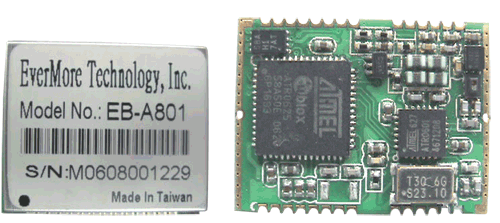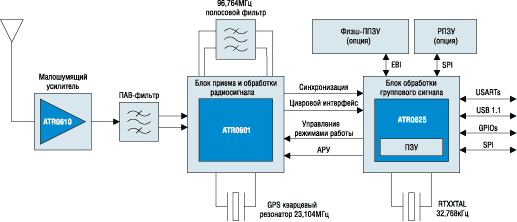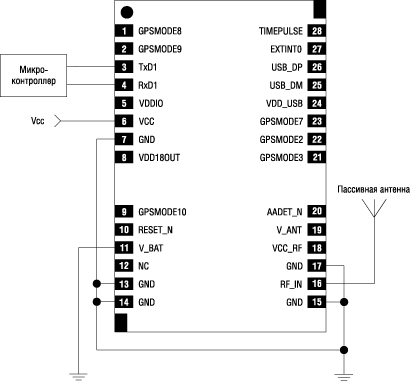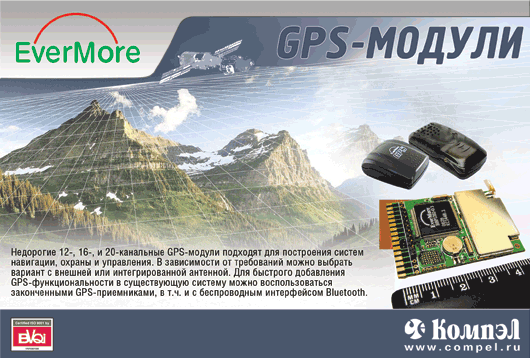Ultra-sensitive GPS modules
Today, Russian developers have access to several dozen built-in GPS modules from various manufacturers. He only needs to choose the receiver that will satisfy his requirements for sensitivity, price, design, etc. But in order to make the right choice, you need to monitor the market situation, new products and development trends. The article contains information about the latest developments by EverMore in the field of OEM GPS solutions.
About company
EverMore, a Taiwanese company, has focused exclusively on GPS products since its founding in 1998. Over the 10 years of its existence, it has managed to accumulate decent experience and acquire a significant nomenclature. This is one of the few GPS product manufacturers that has its own chipset. The company's activities include the production of chipsets, embedded GPS modules, data loggers, and complete personal navigators. By developing its own technologies, EverMore keeps up with the times and uses the best developments in the field of GPS in its products. In addition to its own chipset, the company uses such advanced technologies as Sirf Star III, Antaris 4, Nimerix. This approach provides EverMore products with very broad capabilities and allows them to compete with GPS market leaders, as well as meet the needs of the most specific tasks in the field of navigation. Thanks to this, despite being little known in Russia, the company has a large number of clients in Southeast Asia, Europe and the USA. At the same time, the quality of the products, as well as the production process, including development, assembly and testing, are marked with ISO 9001/14001, QS-9000 certificates.
EverMore and ANTARIS 4
The company recently introduced new OEM modules: EB-A801 and EB-A802-P. Their appearance is shown in Figure 1.

Rice. 1.
These modules are based on the ANTARIS 4 chipset, developed jointly by U-Blox and Atmel. ANTARIS 4 is the core navigation signal processing technology. It provides excellent navigation performance in all conditions, including areas with limited sky visibility or areas with poor signal strength. At the same time, the accuracy of determining coordinates is maintained at the same level. This is achieved by using a large number of correlators that process received signals in parallel, as well as a special integration algorithm. Among other things, the ANTARIS 4 chipset has a built-in temperature-compensated crystal oscillator (TCXO) on board. All this allows you to receive and process data at a signal level approaching -159 dBm. In addition, ANTARIS 4 provides very low power consumption. This fact makes devices based on this chipset extremely attractive for various types of stand-alone applications, where the cost-effectiveness factor is the determining factor in most cases. The ANTARIS 4 chipset includes a set of chips. It includes a low-noise input signal amplifier, a radio signal receiving and processing chip, and a group signal analyzer chip. The presence of such a configuration allows you to create complete, small-sized GPS modules that do not require additional external elements. Figure 2 shows the typical architecture of a GPS module based on ANTARIS 4 technology.

Rice. 2.
Module features
Based on the above, we can conclude that the EverMore EB-A801 and EB-A802-P modules, based on the ANTARIS 4 chipset, have all the advantages of the technology. Due to the fact that the modules include a low-noise input signal amplifier, they are able to work with both active and passive antennas and show excellent performance. A big advantage is the presence of a built-in USB port. This eliminates the need for an expensive serial-to-RS-232 or serial-to-USB converter, making the modules plug-and-play compatible with any PC environment.
The consumption of EB-A801 and EB-A802-P modules is very low. It is only 39 mA. This parameter can be reduced even further by supporting the FixNOW function. When this function is enabled, the module turns off when the GPS signal is lost and turns on at specified intervals to make repeated attempts to “capture” signals from the positioning system satellites. In addition, it is possible to force the module to turn off and on when there is a good signal. This is useful in cases where frequent determination of coordinates is not required. Thus, it is possible to reduce the receiver consumption to 80 μA and increase the battery life of the device.
The EB-A801 and EB-A802-P modules do not require additional initialization. GPS data is transferred immediately after switching on. Support for the special binary protocol UBX allows you to configure the operating modes of the output ports, the types of messages issued, receive “raw data”, enable the fast “capture” mode or the increased sensitivity mode. Both modules provide a high-precision pulse per second (1 pps) synchronized with Universal Time Coordinated (UTC).
The peculiarity of ANTARIS 4 technology is such that modules based on it do not require additional external elements. A typical connection diagram for the EB-A802-P module in a minimal configuration is shown in Figure 3. For its operation, it is enough to connect the antenna, microcontroller and supply power. If an active antenna is used, power must be supplied to the designated terminal.

Rice. 3.
An interesting feature of the modules is support for SBAS (satellite subsystem for differential service) technology. This subsystem includes several technologies: WAAS, EGNOS, MSAS. All of them are supported by modules. The purpose of SBAS is to increase the accuracy of determination using differential corrections transmitted through a network of geostationary satellites. These satellites transmit signals on the L1 frequency, on which all GPS satellites broadcast. This system allows you to increase the accuracy of determining coordinates up to 2 meters.
In general, the parameters of the EB-A801 and EB-A802-P modules are the same. They are shown in Table 1. The main difference is the smaller size of the EB-A802-P and the presence of a built-in EEPROM (PROM). This allows you to save data and configuration of the receiver when the power is turned off, and, if necessary, update the software.
Table 1. Basic technical characteristics of GPS modules from various manufacturers
| Character ristika |
Modules | |||||
|---|---|---|---|---|---|---|
| Naimenov- tion/Production driver |
EB-A801/ Evermore |
EB-A802-P/ Evermore |
LEA-4H/ u-Blox |
LR 9548S/ Leadtek |
A1080-A/ Tyco |
|
| Chipset | ANTARIS 4 | ANTARIS 4 | ANTARIS 4 | SiRF Star III | SiRF Star III | |
| Quantity channels reception |
16 | 16 | 16 | 20 | 20 | |
| Sensitive- ity, dBm |
-158 | -158 | -158 | -159 | -159 | |
| Time to determine coordination nat TTFF, s |
Grief- whose start |
3,5 | 3,5 | <3,5 | 1 | 1 |
| Heat- slow start |
33 | 33 | 33 | 38 | 32 | |
| Cold- new start |
34 | 34 | 34 | 42 | 35 | |
| Accuracy, m (principal- probable ity, %) |
<15 (95) | <15 (95) | 2,5 (50) | 10 | <10 (50) | |
| Protocols | NMEA, UBX, RTCM | NMEA, UBX, RTCM | NMEA, UBX, RTCM | NMEA; SiRF Binary | NMEA | |
| Antenna | passive or active |
passive or active |
passive or active |
active | active | |
| Follow-up body ports |
1xUART; 1xUSB | 1xUART; 1xUSB | 1xUART; 1xUSB | 2xUART | 1xRS232 | |
| DGPS support/SBAS | + | + | + | + | + | |
| Signal 1 pps | + | + | + | + | + | |
| Voltage power supply, V |
3,0…3,3 | 3.3 ±0.1 | 2,7…3,3 | 3,3…5,0 | 3,0…3,6 | |
| Maximum current consumption niya, mA |
39 | 39 | 39 | 49 | 36 | |
| Range operating temperatures, °C |
-40…85 | -40…85 | -40…85 | -40…85 | -30…85 | |
| Dimensions, mm | 24.0×20.0x2.6 | 22.4×17.0x3.0 | 22.4×17.0x3.0 | 24.0×20.0x2.9 | 16.2×19.0x2.4 | |
Comparison of EverMore modules with other popular GPS receivers
To compare the capabilities of the EB-A801 and EB-A802-P EverMore modules, we will consider the basic technical characteristics of GPS receivers from leading Russian manufacturers. Antaris 4 chips are used by many manufacturers of GPS modules. First of all, this is the U-Blox company, one of the creators of this technology. The technical parameters of the most popular model LEA-4H are shown in Table 1. The modules have all the advantages of the technology: high sensitivity (-158 dBm): low power consumption, the ability to work with both active and passive antennas. The accuracy of determining the coordinates is 2.5 meters with a confidence level of 50%. LEA-4H also has a built-in USB port. Another popular technology is SiRF Star III. This chipset is used by manufacturers such as Tyco and Leadtek. Table 1 shows the technical parameters of GPS receivers based on SiRF Star III. These are LR 9548S from Leadtek and A1080-A from Tyco. These modules have excellent sensitivity (-159 dBm). Reception is carried out on 20 channels. Thanks to a larger number of correlators, these modules are able to detect a signal faster. The hot start time is only 1 second. However, their consumption is slightly higher than that of U-Blox and EverMore modules. Although it must be said that the A1080-A module from Tyco itself consumes only 36 mA. But it is only capable of working with an active antenna (just like the LR 9548S from Leadtek), the consumption of which reaches 50 mA. As a result, total energy consumption increases. The lack of a USB port from both manufacturers can also be considered a disadvantage.
Having compared the basic technical characteristics of modules from EverMore with products from leading GPS manufacturers, we see that they are in no way inferior to the favorites. And they may well replace them. At the same time, they turn out to be cheaper than their famous counterparts. It should be noted that the EB-A802-P module is pin-to-pin compatible with the popular LEA-4P from U-Blox. But with sensitivity like LEA-4H.
In conclusion, EverMore's EB-A801 and EB-A802-P modules offer features that make them ideal for a variety of offline, automotive and personal navigation applications. Ease of inclusion, miniature size and absence of external elements can significantly reduce financial and time costs for creating the final product. The features of the miniature design allow for both automatic and manual installation, which is applicable in small-scale production. Combined with an affordable price, the EB-A801 and EB-A802-P modules from Ever More are the best choice for those who want the best technical characteristics at minimal cost.

Obtaining technical information, ordering samples, delivery -
e-mail:
Ultra-low consumption GPS module
Company EverMore announced a new GPS module EB-E36-LP, consuming only 16 mA! The EB-E36-LP is a single-board 12-channel GPS receiver designed for OEM portable marine and land navigation solutions that require good performance at low cost. The receiver operates in the temperature range from -40 to 80°C and has dimensions of 45x31 mm. A special version of the GPS module for aviation applications allows you to issue coordinates with a frequency of 5 times per second. EB-E36 GPS modules are based on EverMore's own chipset.
